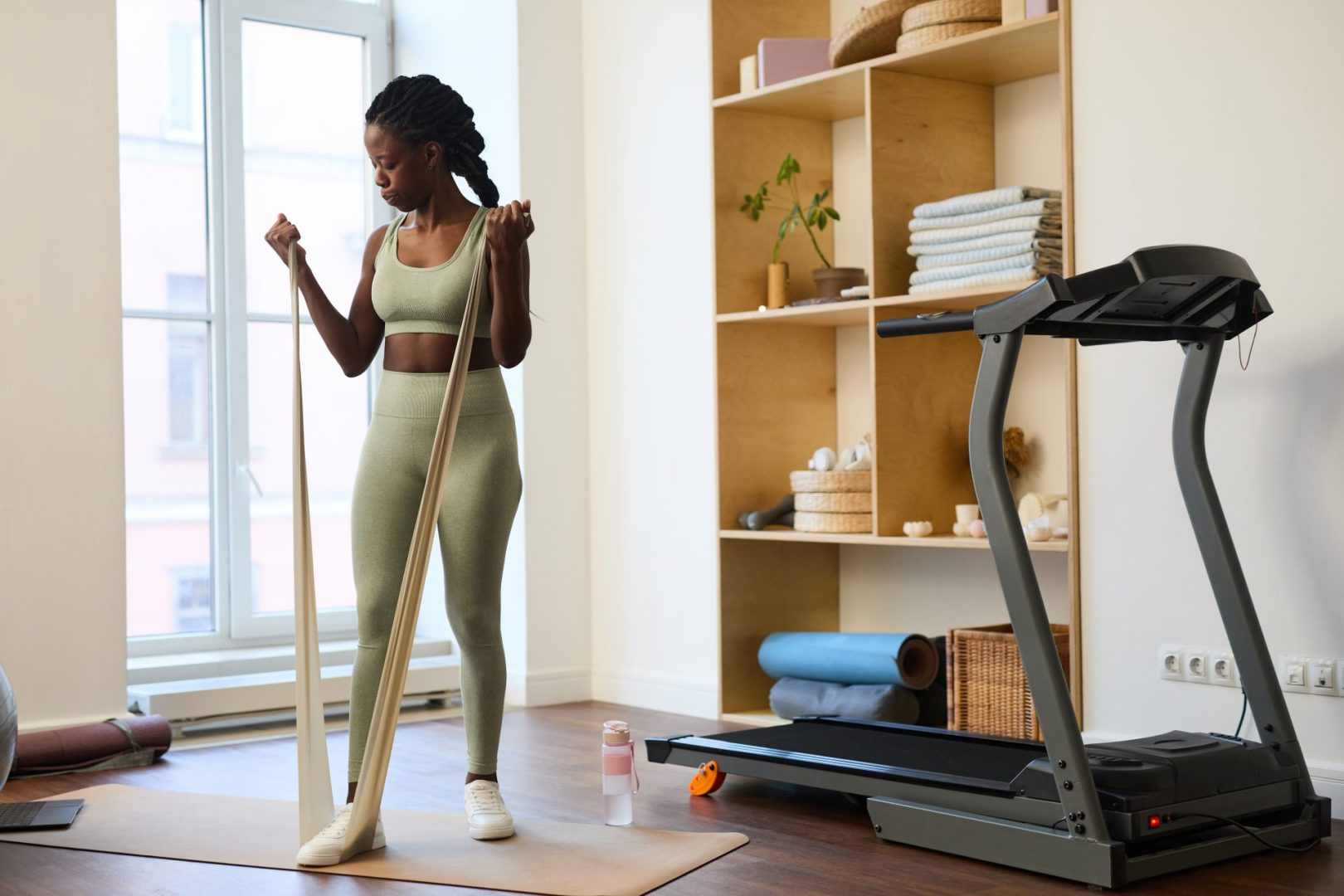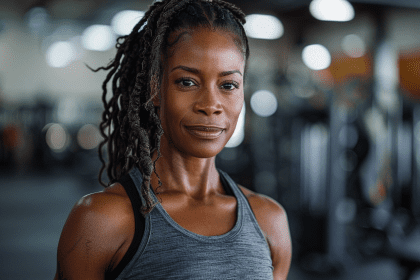The fitness equipment industry generates billions annually selling specialized machines that ultimately perform simple functions: creating resistance against muscle contraction. Resistance bands—portable, affordable elastic tools—provide this same fundamental tension while offering unique advantages over traditional equipment. A single set of quality bands costs between $20-50 yet delivers resistance ranging from 5 to 200+ pounds depending on band combination and positioning.
The effectiveness of resistance band training stems from several mechanical advantages absent in traditional weight training. The variable resistance pattern matches human strength curves more naturally than free weights, creating maximum tension at the strongest points of movement. The omnidirectional resistance also engages stabilizing muscles overlooked by machine-based exercises, developing functional strength that transfers to real-world movements.
Research examining muscle activation patterns during resistance band training reveals comparable or superior recruitment of target muscles versus traditional equipment when exercises are performed with proper form and appropriate band tension. The progressive resistance throughout movement ranges creates continuous tension that stimulates muscle growth through complete repetition paths.
These seven comprehensive exercises, when performed as a complete routine 2-3 times weekly, replace multiple gym machines while delivering equivalent strength development, improved mobility, and enhanced functional fitness.
Standing resistance band squat press transforms lower body routines
The first exercise replaces leg press machines, hack squat stations, and shoulder press equipment with a single integrated movement that builds functional power throughout the kinetic chain.
This compound exercise creates several distinct training advantages:
The progressive resistance matches the body’s natural strength curve in squats. The overhead press component engages the entire shoulder complex rather than isolated pressing muscles. The unstable resistance develops core stability absent from machine alternatives. The standing position requires balance and coordination beneficial for daily movement patterns. The simultaneous lower and upper body engagement creates superior cardiovascular response.
Proper execution involves securing bands under both feet with shoulder-width stance, positioning handles at shoulder height, then simultaneously performing a full squat while pressing overhead at the standing position. The coordinated movement develops timing and whole-body power essential for athletic performance.
For beginners, focus on maintaining vertical shin position and neutral spine alignment throughout the movement. Advanced practitioners can increase intensity by using heavier bands, slowing movement tempo, or adding pulse repetitions at the bottom position.
Unlike machine alternatives that isolate specific muscle groups, this integrated movement teaches the body to coordinate lower body drive with upper body stabilization and pressing—a pattern essential for everything from lifting objects overhead to explosive athletic movements.
Banded deadlift row builds posterior chain development
The second exercise replaces deadlift platforms, cable row machines, and lower back extension stations with a movement that comprehensively develops the posterior chain—the interconnected muscles running from calves through hamstrings, glutes, and spinal erectors to upper back.
This exercise creates distinct advantages over traditional equipment:
The standing position develops balance and coordination absent from seated row machines. The hip hinge pattern trains proper back mechanics essential for injury prevention. The horizontal pull component engages rhomboids and middle trapezius typically undertrained in basic deadlifts. The continuous tension throughout the movement enhances time under tension for muscle development. The integrated hip and back movement reinforces proper lifting mechanics.
Proper execution involves securing the band under both feet, hinging forward with flat back approximately 45 degrees, then simultaneously returning to standing position while pulling bands to ribcage level, squeezing shoulder blades together at the completion of movement.
For maximum effectiveness, focus on initiating the movement through glute contraction rather than lower back extension. Maintain slight knee flexion throughout to properly engage hamstrings. The movement should feel like a coordinated posterior chain activation rather than isolated back pulling.
Unlike separate deadlift and row stations, this integrated movement teaches the posterior chain to work cooperatively, developing the essential strength needed for lifting objects safely, maintaining proper posture, and preventing the lower back injuries that affect over 80% of adults.
Resistance band chest press with rotation replaces multiple upper body machines
The third exercise replaces bench press stations, pec deck machines, and rotational cable equipment with a movement that develops comprehensive upper body pressing strength while enhancing rotational power and shoulder mobility.
This multi-planar exercise creates several advantages:
The instability of band resistance engages stabilizer muscles inactive during machine presses. The rotational component develops transverse plane strength neglected in traditional pressing. The standing position creates core engagement lacking in bench-based exercises. The variable anchor positions allow targeted emphasis on upper, middle, or lower chest fibers. The freedom of movement path accommodates individual shoulder mechanics, reducing injury risk.
Proper execution involves anchoring bands at mid-torso height (door anchor or secured post), positioning body perpendicular to anchor point in athletic stance, then pressing forward while simultaneously rotating torso away from anchor, fully extending arms while maintaining shoulder blade stability.
For maximum chest development, experiment with various foot positions and rotation angles. More forward foot positioning increases chest stretch at movement initiation, while greater rotation increases serratus anterior and external oblique involvement.
Unlike isolated pressing machines that lock the body into fixed movement paths, this integrated exercise develops coordinated pressing power applicable to sports movements, pushing activities, and rotational force generation essential for everything from martial arts to recreational racquet sports.
Banded pull-apart complex develops complete pulling strength
The fourth exercise replaces lat pulldown machines, rear deltoid stations, and various cable pull equipment with a comprehensive movement sequence that develops complete upper back and pulling musculature while enhancing shoulder health.
This movement sequence provides unique benefits:
The multiple angles target all upper back fiber orientations in a single sequence. The scapular retraction emphasis corrects the forward shoulder posture created by modern lifestyles. The external rotation component enhances rotator cuff strength often neglected in traditional pulling exercises. The standing position develops core stabilization during resistance. The movement encourages proper thoracic extension often compromised during seated pulling exercises.
The complete sequence involves four continuous positions with the band held at arms’ length: horizontal pulls with hands shoulder-width, diagonal pulls with hands wider than shoulders, overhead pulls bringing band behind neck, and face pulls with elbows high and hands near ears. Each position is held with isometric contraction before flowing to the next pattern.
For optimal shoulder health benefits, focus on initiating each movement with shoulder blade retraction rather than arm pulling. Maintain tall posture throughout the sequence, avoiding forward head position or lumbar hyperextension.
Unlike isolated pulling machines that work single movement planes, this integrated sequence teaches the upper back to function cooperatively through multiple movement patterns while developing the postural strength essential for preventing the shoulder injuries that affect nearly 20% of adults annually.
Multi-vector lunge pattern replaces complete leg machine circuits
The fifth exercise replaces leg extension machines, hamstring curl stations, adductor/abductor equipment, and rotational hip devices with a comprehensive lower body pattern that develops strength through all planes of movement.
This multi-directional exercise creates distinct advantages:
The unstable resistance develops proprioception absent from machine-based training. The varying vectors train hip stability essential for injury prevention. The unilateral emphasis addresses strength imbalances between legs. The multi-planar movement enhances hip mobility while under load. The functional patterns directly transfer to athletic movements and daily activities.
The complete sequence involves securing bands under the stationary foot while performing controlled lunges in six directions: forward, lateral, diagonal forward, diagonal backward, straight backward, and rotational. Each position emphasizes different aspects of hip and leg musculature.
For maximum effectiveness, maintain vertical shin position on the stationary leg throughout all variations, driving movement through heel rather than forefoot. The torso should remain vertically aligned rather than leaning toward the lunging leg.
Unlike isolated leg machines that train muscles through single movement paths, this integrated sequence develops comprehensive lower body coordination essential for agility, balance and injury prevention. The multi-directional stability directly transfers to sports requiring rapid direction changes and everyday movements like navigating uneven terrain or maneuvering in crowded spaces.
Resistance band core rotational press targets complete midsection development
The sixth exercise replaces abdominal machines, oblique stations, and rotary torso equipment with a standing movement that develops comprehensive core strength while enhancing rotational power generation.
This exercise creates several distinct advantages:
The standing position engages the complete core musculature including deep stabilizers. The rotational component develops power transfer essential for athletic movements. The pressing pattern integrates shoulder stabilization with core activation. The diagonal force vectors target fascial connections throughout the anterior chain. The movement develops deceleration strength crucial for injury prevention.
Proper execution involves anchoring bands at mid-torso height, positioning in athletic stance perpendicular to anchor point, rotating torso away from anchor while drawing handles to chest, then explosively rotating toward anchor while pressing hands fully forward, controlling the return through both rotational and pressing phases.
For maximum anti-rotational core development, focus on maintaining stable hip position throughout the movement, generating rotation from thoracic spine rather than lumbar or hip movement. Control the eccentric (return) phase at approximately twice the duration of the concentric (pressing) phase.
Unlike isolated abdominal equipment that trains muscles through simplified flexion patterns, this integrated movement develops the core as it functionally operates—as a force transfer center connecting lower and upper body while controlling rotational forces. This pattern directly enhances performance in rotational sports while developing the stabilization strength essential for preventing the core and lower back injuries that affect over 60% of active adults.
Banded Turkish get-up sequence develops complete functional movement
The seventh exercise replaces multiple machine stations with an integrated movement sequence that develops whole-body coordination, stability under load, and transitional strength through various positions.
This comprehensive movement creates unique advantages:
The ground-to-standing pattern trains body awareness through all transitional positions. The constant resistance against the extended arm develops shoulder stability throughout multiple angles. The varying base of support challenges core stability through changing leverage points. The controlled movement builds proprioception essential for injury prevention. The sequence integrates mobility and stability simultaneously.
The complete sequence involves starting supine on the floor with band secured under back/shoulders and held in one extended arm, then moving through a coordinated sequence: rolling to elbow, transitioning to hand, sweeping to kneeling position, lunging forward, and finally standing with arm remaining extended throughout, then reversing the entire sequence to return to starting position.
For maximum benefit, move slowly through each transitional position, establishing stability before progressing to the next phase. Focus on maintaining vertical alignment of the extended arm with the shoulder throughout the movement, resisting band tension that attempts to pull the arm forward.
Unlike isolated exercise stations that train specific muscle actions, this integrated sequence develops the body as a coordinated system capable of maintaining stability while transitioning between positions—a fundamental capacity essential for everything from athletic performance to maintaining independence with age.
Creating a complete resistance band training program
These seven exercises, when structured into a comprehensive routine, replace entire gym circuits while delivering comparable or superior results. A complete program involves performing each exercise for 2-3 sets of 10-15 repetitions, with appropriate rest periods between movements.
For optimal results, sequence the exercises in this order:
Start with the Turkish get-up as movement preparation (alternating sides). Proceed to the squat press for main lower body development. Continue with the deadlift row for posterior chain emphasis. Perform the chest press with rotation for upper body pushing. Follow with the pull-apart complex for upper body pulling. Execute the multi-vector lunge pattern for lower body refinement. Finish with the rotational press for core development.
This sequence alternates between upper and lower body emphasis while progressively building fatigue, maximizing both strength development and metabolic response. The complete routine requires approximately 45-50 minutes when performed at appropriate intensity.
For continued progress, apply progressive overload principles by increasing band resistance, adding repetitions, slowing movement tempo, reducing rest periods, or adding isometric holds at positions of maximum tension. This progressive approach ensures continued adaptation regardless of starting fitness level.
Unlike traditional gym programs requiring multiple equipment stations and transitions, this streamlined approach delivers comprehensive fitness development with minimal equipment and space requirements. The portable nature of resistance bands allows this complete program to be performed anywhere—from hotel rooms to outdoor spaces—eliminating the accessibility barriers associated with traditional gym-based training.
By implementing this science-based resistance band program, individuals can develop comprehensive strength, enhance mobility, and improve functional fitness without expensive gym memberships or elaborate equipment setups. The accessibility, effectiveness, and efficiency of this approach makes it a superior alternative to traditional gym-based training for the majority of fitness goals.











